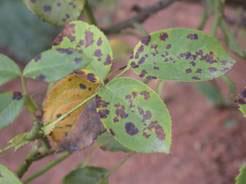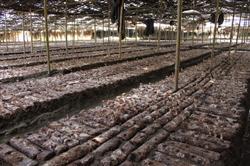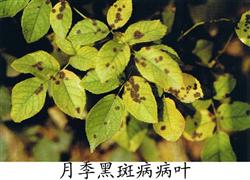Symptoms, prevention and treatment of black spot of rose

Rose black spot pathogen invades leaves, tender shoots and pedicels. At the beginning of the disease, purple-brown dots appeared on the front, which gradually expanded into round or irregular black-brown spots, with a diameter of 1-12 mm, and the edge of the spot was radiate, which is the characteristic symptom of black spot disease. In the later stage, the leaves turned yellow, the center of the disease spot was gray-white, and there were small black spots on it, which was the conidia disk of the pathogen. Some rose varieties are often surrounded by yellow halos around the disease spots. Some varieties often have several disease spots linked to yellow patches, while the edge of the disease spot is still green, which is called "green island". When the disease is serious, the lower and middle leaves of the plant fall off completely, leaving only a few new leaves at the top. The black spot of rose is caused by the infection of Rosa actinomycetes of the subphylum Coleophora, Coleophora, Alternaria, Acanthosporaceae and actinomycetes. The conidia of the pathogen are produced in the conidia disk, and the conidia are long oval or oval, double-celled, which infect and spread. The temperature range of growth and development of the pathogen is 10-35 degrees Celsius, and the optimum temperature is 20-25 degrees Celsius. Rose black spot pathogen overwinters as hyphae or conidia on bud scales, leaf scars, withered shoots and fallen leaves. The conidia were produced after the rain in the following spring, which were spread by wind and rain and splashed with water, and invaded directly from the epidermis. Under the suitable conditions of temperature and humidity, the shortest incubation period could be 3-6 days, the onset of disease was about 8-32 days, and the shedding period of diseased leaves was shortened when the temperature was high. The peak period was from late March to mid-June and from late September to November. Rainy, dewy, muggy after wind and rain, poor ventilation, as well as weak and old plants, the disease is more serious. In general, varieties such as "Jinbu", "goldfish red", "peace" and "golden branches and jade leaves" are most susceptible to disease. "Elizabeth", "black thousand layers", "Isbel" and other varieties are more resistant to disease. No immune varieties were found. Control methods: 1. Clean the fallen leaves at any time, remove the diseased leaves, and prune to control the branch density. It is best to use drip irrigation, furrow irrigation or watering along the edge of the basin to shorten the retention time of water droplets on the leaf surface and keep the leaves dry. 2. Spraying topsoil with 1% copper sulfate, or covering topsoil with wood chaff and coal ash, with a thickness of about 8 mm, can kill some germs on the surface and reduce the chance of infection. 3. During the onset of the disease, spray 75% chlorothalonil 600,800 times or azinamide 1000 times.
- Prev

How to improve the efficiency of mushroom cultivation
At this stage, due to the proliferation of a large number of hyphae, not only a large number of hyphae, but also stored rich nutrients, at this time hyphae have entered the physiological maturity, such as continue to give constant temperature, sufficient water and fresh air, hyphae will maintain an active growth state, difficult to enter the fruiting body this stage. Therefore, in bacteria...
- Next

Preventive measures of Black spot of Rose
Rose black spot is a stubborn disease harmful to rose, which mainly occurs in leaves, twigs and pedicels. Most of the disease spots occur on the front of the leaves, and all the leaves from the lower to the middle of the seriously diseased plants will fall off, making the plant grow weakly, easily injuring the flower buds by low temperature, affecting flowering in the coming year, and even causing branches to die. The author.
Related
- Fuxing push coffee new agricultural production and marketing class: lack of small-scale processing plants
- Jujube rice field leisure farm deep ploughing Yilan for five years to create a space for organic food and play
- Nongyu Farm-A trial of organic papaya for brave women with advanced technology
- Four points for attention in the prevention and control of diseases and insect pests of edible fungi
- How to add nutrient solution to Edible Fungi
- Is there any good way to control edible fungus mites?
- Open Inoculation Technology of Edible Fungi
- Is there any clever way to use fertilizer for edible fungus in winter?
- What agents are used to kill the pathogens of edible fungi in the mushroom shed?
- Rapid drying of Edible Fungi

